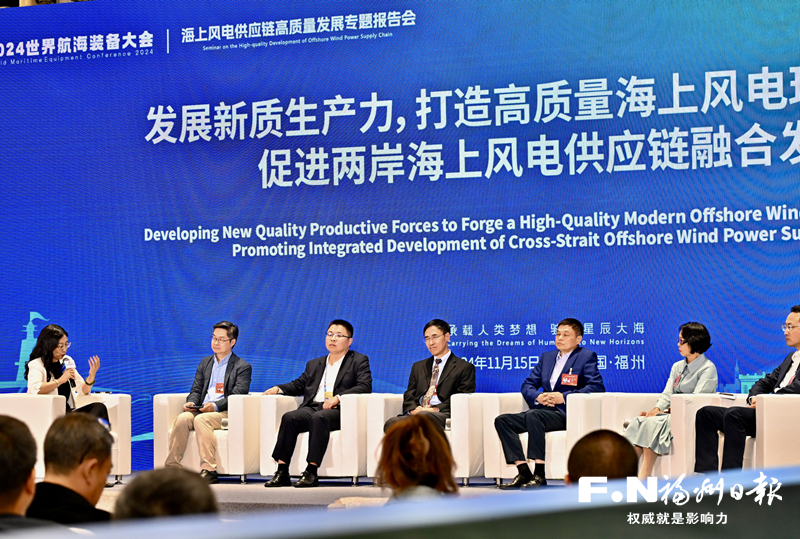Riding the Wind Forward for the Bright Future of Offshore Wind Power
Observations from the Seminar on the High-quality Development of Offshore Wind Power Supply Chain
The wind comes from the sea and now is the right time to harness its power. On the afternoon of November 15, the Seminar on the High-quality Development of Offshore Wind Power Supply Chain was held in Fuzhou. Representatives from upstream and downstream companies in the industry chain, research institutions, design firms, and other sectors gathered to discuss topics such as innovation-driven development, collaborative chain cooperation, and win-win partnerships. The session focused on exploring the path for the coordinated development of the offshore wind power industry, enhancing the resilience and competitiveness of the supply chain, and fostering a shared consensus on the high-quality development of China’s offshore wind power supply chain.

On-site Picture of Seminar on the High-quality Development of Offshore Wind Power Supply Chain Reporter: Zheng Shuai / Photography
Seizing Opportunities: The Bright Future of Offshore Wind Power Development
“The ocean covers more than 70% of the Earth’s total surface area, is an essential component of the life support system, and a valuable asset for the sustainable development of human society,” said Zhao Zhenye, Academician of the Chinese Academy of Engineering. He believes that offshore wind power has significant advantages, with the most favorable conditions for large-scale development, and commercial viability, and is also a renewable clean energy source.
As the global energy transition accelerates, offshore wind power is entering an unprecedented era of rapid development. Xie Hongwen, Chief Technical Expert and Deputy Chief Engineer of China Renewable Energy Engineering Institute presented data showing that by the end of 2023, global wind power installed capacity reached approximately 1.021 billion kilowatts, surpassing the 1 billion kilowatt mark for the first time. Offshore wind power installed capacity reached about 75.2 million kilowatts, with 10.8 million kilowatts added that year. China's newly added installed capacity has ranked first in the world for six consecutive years, accounting for 58% of the global new installations.
The rapid development of emerging industries relies heavily on strong policy support. Xie Hongwen introduced several policies recently implemented in China, including the Action Plan for Carbon Dioxide Peaking Before 2030, the Implementation Plan for Promoting High-Quality Development of New Energy in the New Era, and Opinion on Accelerating the Comprehensive Green Transition in Social and Economic Development. These policies all encourage the construction of offshore wind power bases and the expansion of offshore wind power into deep-water and distant offshore areas. Based on more than a decade of technological experience in offshore wind power in China, the entire industry must be confident in its development, adhere to high standards of construction, and promote the safe and sustainable development of offshore wind power.
Facing Challenges: Enhancing Core Competitiveness through Innovation
Exploring the seas requires advanced equipment. Zhao Zhenye emphasized that high-end wind power equipment manufacturing is a key indicator of maritime power, but it is a complex system. The key components are the core of wind power equipment manufacturing; without high-end key components, it is like cooking without rice, and without advanced manufacturing technology, it is akin to mere theoretical discussions. He believes that fatigue resistance manufacturing technology is a new generation of advanced technology, new quality productive forces, and an important way to develop high-end offshore equipment and achieve the goal of building maritime power.
As the offshore wind power industry continues to develop at an accelerating pace, companies across the industry chain are facing new opportunities and challenges. Dong Zhaolong, Market Director of the Wind Power Industry Group at Goldwind Technology Co., Ltd., stated that the development of domestic offshore wind turbines is characterized by rapid and large-scale advancements. In recent years, there has been a clear growth trend in the rotor diameter and rated power of offshore wind turbines. The single-machine capacity of offshore turbines has now surpassed 20 megawatts, with rotor diameters reaching 300 meters. In this process, the boundaries of knowledge are continually being expanded, and collaborative innovation is needed in various fields such as simulation, design, processes, and installation. To address this, he suggested building a comprehensive simulation capability for the entire chain of “wind-load-structure-stability”, forming a “digital twin-physical entity” closed-loop verification system, and fully penetrating core underlying technologies.
Blades are the core components of wind power generation equipment. Li Chengliang, R&D Director of Sinoma Wind Power Blade Co., Ltd., believes that the large-scale development of offshore blades has entered “uncharted territory”, facing numerous pain points and difficulties. For high-quality development of wind power blades, it is essential to achieve greater stability and sustainability, accelerate innovation in new materials, new designs, and new equipment, and ensure the safety and reliability of wind turbines throughout their entire lifecycle.
“Developing the wind power industry is a long-distance race, relying on innovation to drive core competitiveness, and achieving a win-win outcome through collaboration among industry, academia, research, and application,” said Li Chengliang. He emphasized that for the high-quality and sustainable development of the wind power industry, it is necessary to jointly address industry technical challenges, integrate resources across the entire industry chain, and innovate collaboratively to achieve industry-wide win-win results and healthy, sustainable development.
Local Practice: Fuzhou Accelerates the Construction of an Offshore Wind Power Industry Hub
In recent years, China has accelerated the construction of an offshore wind power industry system at an internationally leading level. The manufacturing capacity for wind power equipment has remained among the top in the world, and a series of original and groundbreaking technological achievements have emerged like mushrooms after the rain.
Last month, the world’s largest 26-megawatt offshore wind turbine was rolled off the production line at the Fujian Three Gorges Offshore Wind Power International Industrial Park. This is currently the world's largest offshore wind turbine in terms of single-machine capacity and rotor diameter, and it represents the latest achievement in the rapid technological progress of China’s entire wind power equipment industry chain.
Since 2019, the Fujian Three Gorges Offshore Wind Power International Industrial Park has successively rolled out offshore wind turbines with capacities of 6.7 megawatts, 8 megawatts, 10 megawatts, 13 megawatts, 13.6 megawatts, 16 megawatts, 18 megawatts, and 26 megawatts, driving the leap-forward development of China's offshore wind power equipment manufacturing.
Today, the Industrial Park has attracted leading enterprises such as Goldwind, Dongfang Electric Corporation, and CRRC, forming a complete industrial chain including structural components, motors, blades, and complete wind turbines. The park has the capability for annual production of over 3 million kilowatts of wind turbines and key components, along with distribution and after-sales services. It provides a platform for innovation in large-capacity offshore wind turbines in China.
Going forward, Fuzhou will continue to rely on the Fujian Three Gorges Offshore Wind Power International Industrial Park to further implement the "chain leader system" for the industry chain, actively introduce upstream and downstream supporting projects, and accelerate the development of an advanced manufacturing base for offshore wind power equipment. (Reporter: Yan Lanping / Text, Zheng Shuai / Photography)







